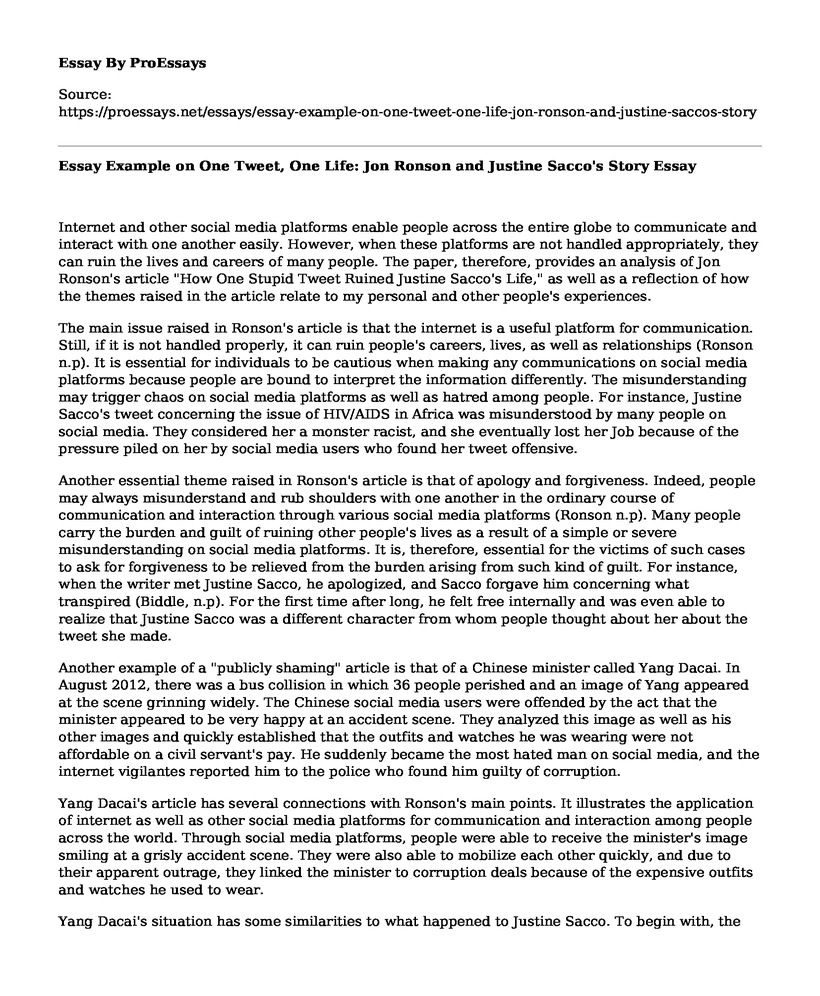Internet and other social media platforms enable people across the entire globe to communicate and interact with one another easily. However, when these platforms are not handled appropriately, they can ruin the lives and careers of many people. The paper, therefore, provides an analysis of Jon Ronson's article "How One Stupid Tweet Ruined Justine Sacco's Life," as well as a reflection of how the themes raised in the article relate to my personal and other people's experiences.
The main issue raised in Ronson's article is that the internet is a useful platform for communication. Still, if it is not handled properly, it can ruin people's careers, lives, as well as relationships (Ronson n.p). It is essential for individuals to be cautious when making any communications on social media platforms because people are bound to interpret the information differently. The misunderstanding may trigger chaos on social media platforms as well as hatred among people. For instance, Justine Sacco's tweet concerning the issue of HIV/AIDS in Africa was misunderstood by many people on social media. They considered her a monster racist, and she eventually lost her Job because of the pressure piled on her by social media users who found her tweet offensive.
Another essential theme raised in Ronson's article is that of apology and forgiveness. Indeed, people may always misunderstand and rub shoulders with one another in the ordinary course of communication and interaction through various social media platforms (Ronson n.p). Many people carry the burden and guilt of ruining other people's lives as a result of a simple or severe misunderstanding on social media platforms. It is, therefore, essential for the victims of such cases to ask for forgiveness to be relieved from the burden arising from such kind of guilt. For instance, when the writer met Justine Sacco, he apologized, and Sacco forgave him concerning what transpired (Biddle, n.p). For the first time after long, he felt free internally and was even able to realize that Justine Sacco was a different character from whom people thought about her about the tweet she made.
Another example of a "publicly shaming" article is that of a Chinese minister called Yang Dacai. In August 2012, there was a bus collision in which 36 people perished and an image of Yang appeared at the scene grinning widely. The Chinese social media users were offended by the act that the minister appeared to be very happy at an accident scene. They analyzed this image as well as his other images and quickly established that the outfits and watches he was wearing were not affordable on a civil servant's pay. He suddenly became the most hated man on social media, and the internet vigilantes reported him to the police who found him guilty of corruption.
Yang Dacai's article has several connections with Ronson's main points. It illustrates the application of internet as well as other social media platforms for communication and interaction among people across the world. Through social media platforms, people were able to receive the minister's image smiling at a grisly accident scene. They were also able to mobilize each other quickly, and due to their apparent outrage, they linked the minister to corruption deals because of the expensive outfits and watches he used to wear.
Yang Dacai's situation has some similarities to what happened to Justine Sacco. To begin with, the two were both victims of social media users' misunderstanding as well as outrage. Justine Sacco was fired from being the global head of communications for the digital media conglomerate IAC because of the tweet she made, which did not make ogre well with other social media users. Yang Dacai, on the other hand, was found guilty of engaging in corruption after being reported to the police by social media users who were offended by his image, which emerged smiling widely at a fatal accident scene in China.
There is, however, a notable difference between Yang Dacia's article and other Ronson mentions. Ronson mentions apology and forgiveness as critical issues whenever misunderstanding arises among different users of social media platforms (Ronson n.p). On the other hand, there is no aspect of apology and forgiveness in the case of Yang Dacai. The social media users do not feel any guilt and need to ask for forgiveness even if they are the ones responsible for Yang Dacai being found guilty of corruption by the police.
Conclusion
In summary, it is evident from the above discussion that internets, as well as other social media platforms, are useful for communication and interaction among different people globally. When people fail to exercise caution when using social media platforms, they can lead to extremely unbearable consequences. These consequences include misunderstanding, chaos, and outrage among social media users, as well as the loss of one's career. Individuals should be careful when using social media platforms to avoid the negative implications which may arise.
Works Cited
Biddle, Sam. Justine Sacco is Good at her Job, and how I came to Peace with her. 2014.
Ronson, Jon. How one stupid tweet blew up Justine Sacco's life? 2015.
Cite this page
Essay Example on One Tweet, One Life: Jon Ronson and Justine Sacco's Story. (2023, Apr 24). Retrieved from https://proessays.net/essays/essay-example-on-one-tweet-one-life-jon-ronson-and-justine-saccos-story
If you are the original author of this essay and no longer wish to have it published on the ProEssays website, please click below to request its removal:
- Art Work Details and Description: Mona Lisa
- Evaluating an Integrated Marketing Communication Program of Walmart
- Paper Example on Intelligence Community
- Essay Example on Effective Communication: Nonverbal, Visual & Electronic
- Essay Example on Sufism: Music, Rituals & Ambiguities
- The 'New World' Symphony: Antonin Dvorak's Ninth Masterpiece - Essay Sample
- Essay on Musee d'Orsay: Home to the Finest French Art 1848-1914







